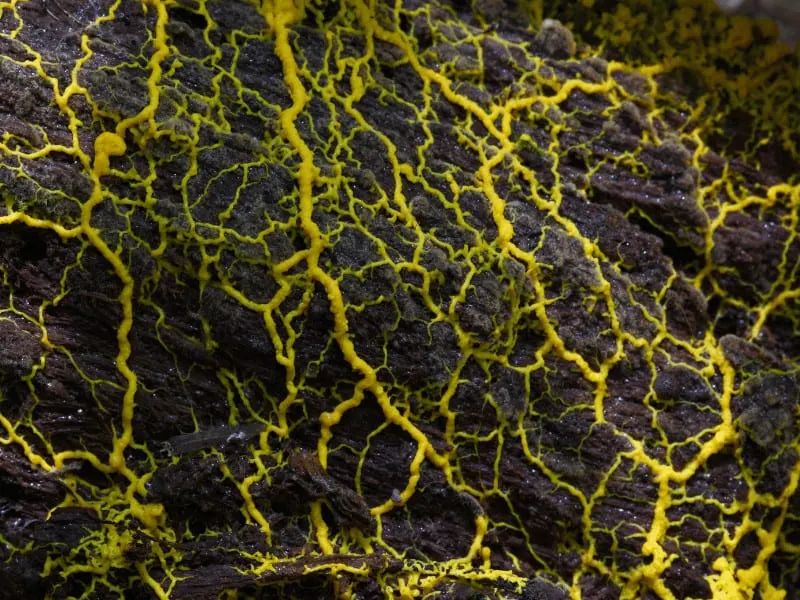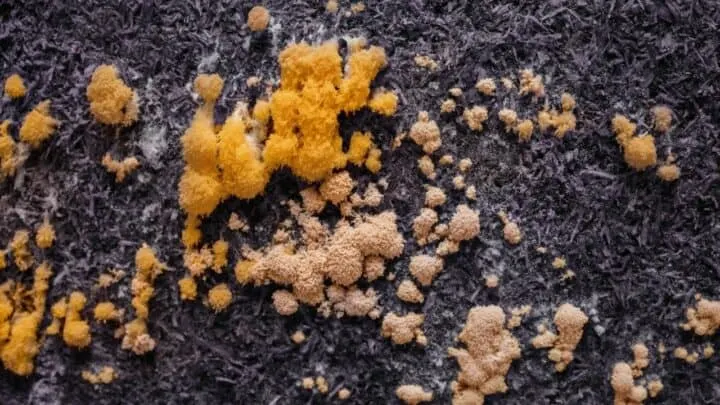The first time I saw yellow mold in my plant soil, I thought something had died or perhaps an alien had landed there.
Seeing this bubbly, slimy, and disgusting-looking blotch on the soil under my lavender bushes was so strange.
What was it?
Table of Contents
Yellow Mold in Plant Soil
Yellow mold in plant soil, scientifically known as Fuligo septica, is related to the seaweed family. Although not toxic to humans unless ingested in large quantities, it can be unsightly and harmful to plants, pets, and children who consume contaminated soil.

How Yellow Mold Forms in Plant Soil
There are several ways in which yellow mold forms in plant soil, and it can form quickly— overnight, it seems!
Infected Soil
Sometimes, your pot plants bring in yellow mold from a nursery or garden center.
You may also inadvertently introduce the spores for yellow mold when you top up your existing pots with soil or potting mix that has been contaminated.
When conditions are right for these spores to germinate and grow, you will soon see yellow blotches all over the soil in your pot plants or garden beds.
Too Much Water
A second reason yellow mold may form is if the soil is too wet, which creates a situation where mold quickly thrives.
Excessive amounts of water will create moldy soil surfaces, where yellow mold quickly roots.
Fertilizers With Contaminants
Adding in fertilizer, especially organic fertilizers and compost, can introduce mold spores that will sprout in the nutrient-rich environment of your plant bed or pot plant.
Low Light Conditions
Plants don’t do so well in low lighting conditions, yet mold, especially yellow mold, thrives in low-lighting conditions.
That out-of-the-way pot plant in your bathroom will be an ideal environment for yellow mold to appear in.
The plant is probably getting too much moisture, and it is in a low-light environment with little to no UV light or sunlight that would have killed off the mold.
In the garden, garden beds under large trees where little sunlight can reach will usually be ideal breeding grounds for yellow mold too.
You will find mold forming on tree roots, underexposed brickwork, and among your prized ferns that do so well with low light.
Waterlogged Soil
The last condition that leads to yellow mold forming is when the soil is waterlogged.
This creates a moist environment, which is ideal for yellow mold, and the water smothers the soil, removing excess oxygen.
Mold is a plant that prefers lower levels of oxygen, and it can even grow anaerobically (without oxygen).
How to Get Rid of Yellow Mold in Potted Plants
While yellow mold isn’t toxic to humans if left alone in your pot plants, it is unsightly, and removing it can be challenging.
In the garden, removing yellow mold is slightly more difficult as your “container” is the whole garden.
Here are some excellent ways I use to remove yellow mold from my pot plants and ensure it doesn’t return.
Clear Away Organic Matter
My first step is to remove the organic matter the yellow mold is growing on. A mold of any kind loves rotting vegetation, so a few decomposing leaves or twigs are a natural starting place for it.
I rake away any leaves, twigs, or flowers that may be lying around the base of my plants.
I may also resort to scraping away any infected soil. Mold isn’t deep rooting, so if I can remove the first quarter inch of soil, it usually takes all the mold spores and roots with it.
Avoid dropping any of the soil back into the pot. I then replace the top layer of soil with fresh potting soil.
If there are any decorative stones or shells in the pot, these need to be removed, washed, and sprayed with fungicidal spray before being returned to the pot.
Should the mold return again in a few days, I proceed to the next measures I can take.
Repot the Plant
I repot the plant at this point, even if there is only a small patch of infected potting soil. This helps me to get rid of plenty of the yellow mold and its spores.
After removing the old potting soil, I replant the plant in a sterile potting mix. The old potting soil may need to be thrown away if it is heavily infected, as it may not be worth cleaning it.
If the infection isn’t that severe, I may open it in a sunny spot, letting it dry out and spraying it with a fungicide.
Enlist Nature’s Help With Natural Fungicides
If the plant still seems to attract mold, then I opt for the route of spraying fungicides. Nature has some amazing options available to us.
I like using a solution of weak apple cider vinegar and water, which I spray on the base of the plant and the soil.
I may also opt for mixing in a few drops of neem oil, a wonderful fungicidal that won’t damage the plant.
If you want, you can also sprinkle cinnamon powder on top of the soil, repelling mold spores. In addition, your home will have a wonderful smell too.
Frequently Asked Questions
How do you get rid of the yellow fungus in soil?
The easiest way to remove yellow fungus or yellow mold from the soil is to scrape the top layer of soil away as the roots of mold or fungus are microscopic and don’t go deep into the soil.
Is yellow mold on soil dangerous?
Yellow mold is only dangerous or toxic when ingested or if you have a huge infection in your house plants that may release spores into the air. However, it is best to remove yellow mold as some people may be allergic to any mold, and it is unsightly to see these yellow splotches in your plants.
Breaking the Mold
While yellow mold isn’t toxic and doesn’t always seem to damage plants, I prefer to remove it to be on the safe side.
Since my home is always filled with pets and people, it is safer not to have an organism that produces spores in my potted plants.
Removing it is a process of trial and error, but with sustained effort, you will be able to remove all yellow mold from your pots soon enough.

Daniel has been a plant enthusiast for over 20 years. He owns hundreds of houseplants and prepares for the chili growing seasons yearly with great anticipation. His favorite plants are plant species in the Araceae family, such as Monstera, Philodendron, and Anthurium. He also loves gardening and is growing hot peppers, tomatoes, and many more vegetables.


